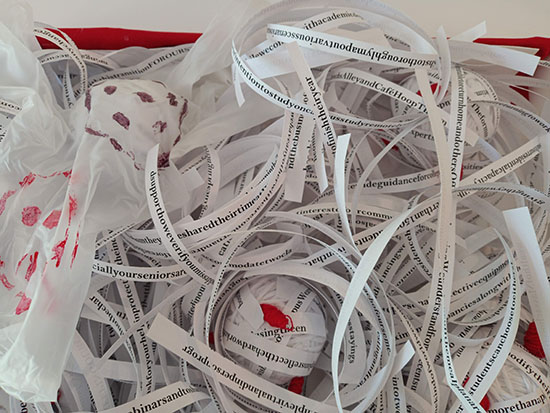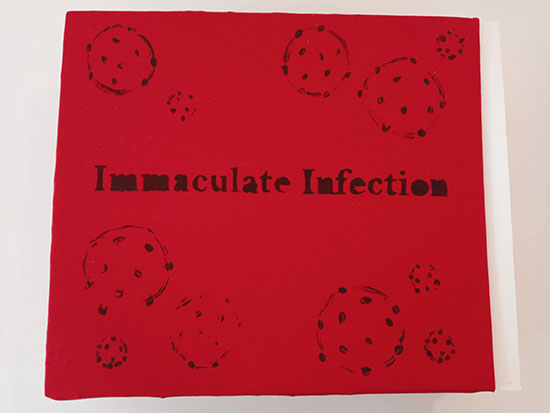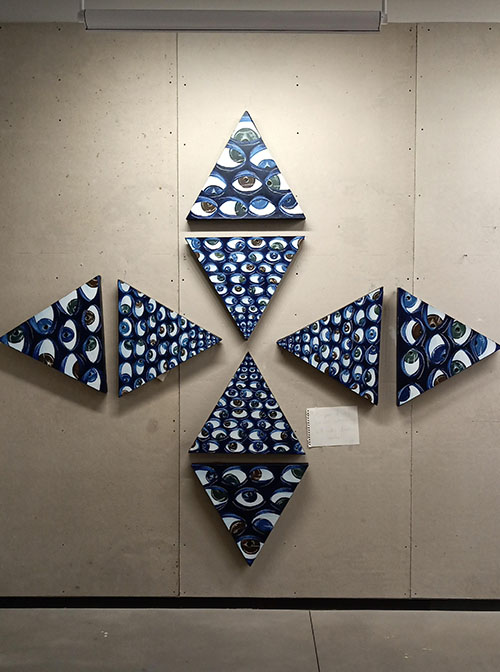Ally Gago:
This year has been tumultuous for a variety of reasons, most notably the global pandemic that has upended our sense of daily routine and comfort. As I left Wellesley last year in March during the middle of my junior year, I was unsure what my senior year was going to look like. As I write this reflection currently, a few days out from being released from COVID-19 isolation, I can look back on the past few months with amazement at how much has happened. Time has been so weird recently, both going so fast and so slow. I wanted to create a time capsule in the form of my final project.
Primarily, this project is an exploration of the artist book as archive. I have been keeping record of all the emails sent by administration regarding COVID-19. I have a penchant for saving emails in different folders, and these emails seemed like they would be important to be able to look back on, so I began saving them all in a folder called “Spring 2020/COVID-19”. I had plans to delete them when COVID was over and we were back to normal – at this point in time, I do not know when that will be. For this project, I selected various emails that were the most important to me – the email that sent us home for the semester, the email detailing the plans for the fall semester, the email detailing the first COVID case on campus – and edited them all together, removing punctuation and space from the text. I decided it was not so much important that viewers be able to see the text and read specific words, but instead know that words from the emails were present in the book.
This project consists of an artist book in the format of a clamshell box filled with shredded text. Nestled amongst the shredded text are the representations of four COVID viruses – comprised of cotton yarn, text, and the iconic red proteins – as well as two printed gloves with virus-free cells inside of them. I chose red to be the only color I used in this project, as that is the color that we all associate with the virus.
During its production, this project took a more personal turn, being diagnosed with COVID-19 myself and experiencing everything that follows. I moved out of my room and into isolation. I experienced the wide array of symptoms that COVID-19 causes. Starting this project and getting into the studio to print was delayed thanks to the virus. The more I thought about things, the more ironic this project became. What were the chances that I would be working on a COVID-related project and get COVID? The title was even inspired by what my parents decided to call my infection with COVID – the “immaculate infection,” since it seemed to come out of thin air.
I am curious to see how this project’s relevance changes as we get further and further away from living in a pandemic. Right now, all we can think about is COVID – everything we do now is influenced by the virus. Will this artist books still have the same impact five years from now?
Or will COVID be a distant memory? How will this artist book serve as an archive of what it was like to be a college student during the pandemic? Although the viewer cannot currently interact with the book in person due to COVID restrictions, my hope is that one day viewers will be able to touch the book, interact with the “viruses,” and reflect on past COVID-times.
oil on canvas
2019
Can we perceive the gaze of an inanimate object?
Comprised of dozens of individual eyes, this octaptych is an exploration of how the viewer interacts with the gaze of a subject of a painting. With the format I chose, I wanted to represent a gaze that was seemingly infinite, with nowhere for the viewer to rest their eyes and escape. Although on a flat plane, the eyes appear to be drawing the viewer in to the center of the star, encouraging them to get closer and stare back at the inquisitive eyes.
What does it mean for a painting to stare (quite literally) at you?
My work often dances around the disconcerting. It has been a goal of mine to present the viewer with an image peppered with tiny details that become more apparent the longer they view the work. Something – sometimes a very prominent part of the painting, other times a very minor part – is always created to be slightly off-putting. This final project is no different, what with dozens of disembodied eyes peering at the viewer amidst a midnight-blue skin. Although the eyes are fairly life-like, something about them prevents us from perceiving them as totally human.
Who do these eyes belong to?
Although this work is primarily meant to be disconcerting, the arrangement of the eight canvases is also representative of the spiritual. With this painting, I hoped to create a reverent, yet agitated atmosphere. The star formation the canvases are arranged in, along with the multitude of earth toned eyes on a dark-blue canvas, washes the viewer with a sense of peace, yet the work begs the question as to the origin of the eyes. I drew upon Biblical descriptions of angels (or seraphim) to produce the final version of this work, implying that the owners of these eyes might be otherworldly.
What are they watching?
The eyes are watching the viewer – just looking, watching, and observing.






